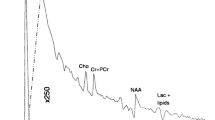Abstract.
Nonketotic hyperglycinemia (NKH) is an inborn error of amino acid metabolism caused by a defect in the glycine cleavage multienzyme complex resulting in high concentrations of glycine within the brain and spinal cord. Quantitative magnetic resonance spectroscopy (1H-MRS) allows measurement of absolute glycine concentrations within different parts of the brain in vivo. In addition, 1H-MRS may be useful in monitoring treatment of NKH and to differentiate this disease from other disorders of glycine metabolism.
Similar content being viewed by others
Author information
Authors and Affiliations
Additional information
Electronic Publication
An erratum to this article is available at http://dx.doi.org/10.1007/s00330-002-1497-9.
Rights and permissions
About this article
Cite this article
Huisman, T., Thiel, T., Steinmann, B. et al. Proton magnetic resonance spectroscopy of the brain of a neonate with nonketotic hyperglycinemia: in vivo–in vitro (ex vivo) correlation. Eur Radiol 12, 858–861 (2002). https://doi.org/10.1007/s003300101073
Received:
Revised:
Accepted:
Published:
Issue Date:
DOI: https://doi.org/10.1007/s003300101073




